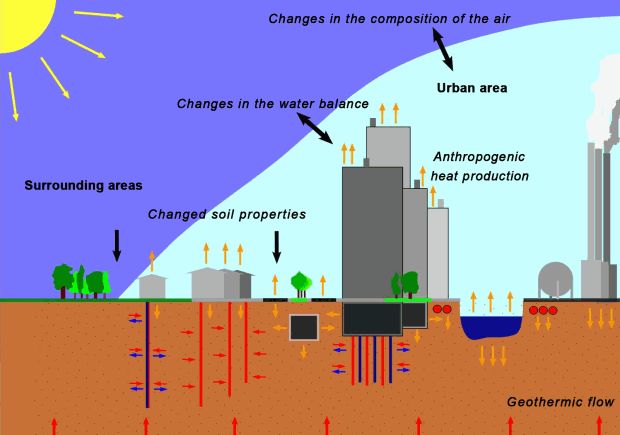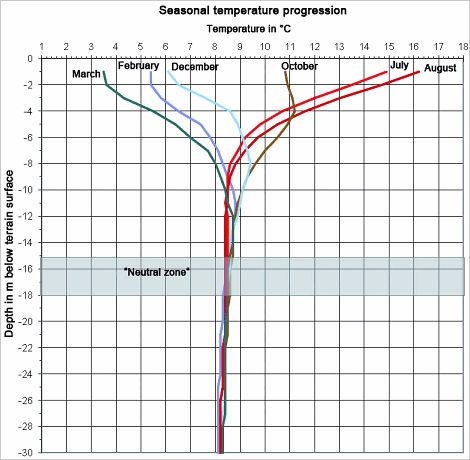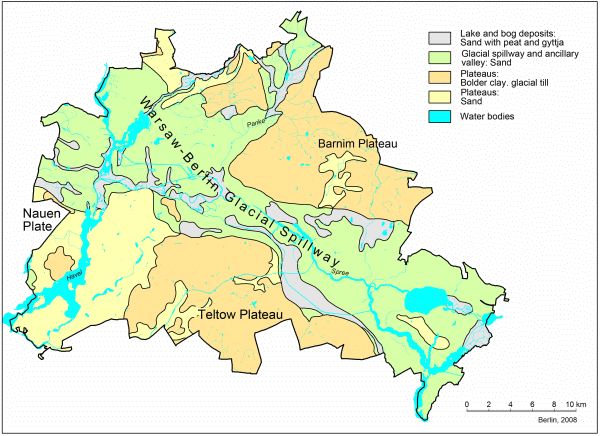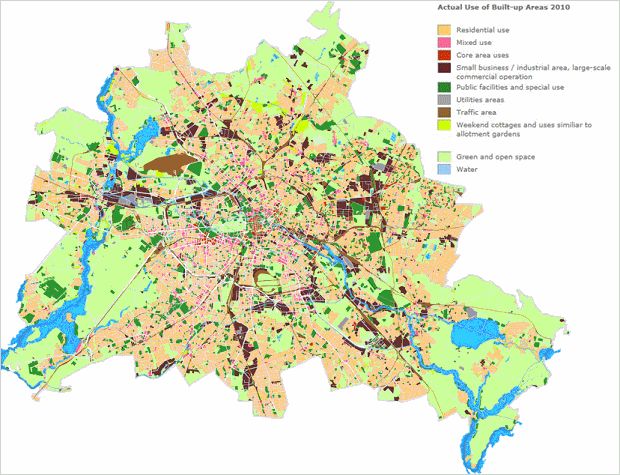The causes of the temperature rise are various, and are directly connected to the continuing structural developments and the existing uses at the earth’s surface. There, the distinction is made between direct and indirect influences on the groundwater temperature (see Fig. 1).
-
Direct influences on the groundwater temperature includes all heat inputs to the groundwater through the sewage network, district-heat pipes, power lines and such underground structures as auto and metro-tunnels, underground garages, etc.
-
Indirect influences on groundwater temperature processes of urbanization connected with the change in the heat balance of the near-surface atmosphere. According to Gross (1991), the most important factors are:
- The disturbance of the water balance due to a high degree of surface imperviousness
- The change of thermic surface characteristics, such as surface heat conductivity and heat capacity due to surface imperviousness and concentration of structures
- Changes in the irradiance balance due to changes in the atmospheric composition
- Anthropogenic heat generation (domestic heating, industry and transport).
These differences cause changes in the heat balance by comparison with the areas surrounding the city.
The city is gradually heating itself up, storing ever more heat overall, and gradually passing it on again to the surrounding areas, i.e., it can generally be considered a huge heat storage unit. Over the long term, this process leads to an increase in the annual mean air temperatures (cf. Map of long-term mean air temperatures, 1961-‘90; Map 04.02).
The long-term warming also leads to a heating of the groundwater. The physical qualities and the chemical and biological nature of the groundwater are temperature-dependent. As a result of such warming, a deterioration of groundwater quality and an impairment of the groundwater fauna may result.
One hundred percent of Berlin’s drinking water comes from groundwater, which is extracted almost exclusively from the territory of the State of Berlin. The groundwater also supplies a large share of the water for industrial use. Therefore, the protection of the groundwater from serious change, such as a significant increase in groundwater temperature, is of great importance – especially in the interests of sustainable water management.
Since 1978, temperature profiles have increasingly been recorded at deep groundwater measurement points distributed throughout the area of the city, in order to ascertain and observe changes.
The purpose of the present map is:
- The extrapolation of the existing documentation on temporal change of the groundwater temperature beneath the municipal area
- To serve as a basis for the authorization of measures which could cause changes in the groundwater temperature, and
- To provide input data for the planning and evaluation of facilities for the use of geothermal energy.
In addition, it can, in combination with other topical maps, such as the Geological Outline Map (Map 01.17), the Groundwater Levels and Catchment Areas Map (Map 02.12), or the Geothermal Potential Map (Map 02.18), be used as an aid for decision-making and for preliminary planning for energy management of the groundwater. The underground temperature is an important quantity for the installation of ground heat exchangers.
Groundwater Temperature and the Annual Temperature Curve
The major heat source for the near-surface subsoil to a depth of approx. 20 m is the solar irradiance which reaches the earth’s surface. This is substantially responsible for the surface temperature.
The near-surface soil is heated by irradiated solar energy, and passes the heat on to the atmosphere and to the subsoil. The annual total of that part of the solar irradiance which impacts upon a horizontal surface, the so-called global irradiance, averages approx. 1000 kWh per sq. m and year in the State of Berlin. A number of parameters at the air-surface interface affect the local thermic climate. Colour, composition, surface roughness, degree of ground cover, the water balance and the orientation of solar irradiation upon urban surfaces determine how much energy is absorbed and "stored" in the building structures, and how much of that is passed on to the atmosphere or the subsoil.
Basically, the temperatures of the earth’s surface, and hence, too, the heat entry or exit, are subject to periodic fluctuation in a cycle of one year, which corresponds to the progression of the seasons.
The surface temperature penetrates the soil with decreasing intensity. The penetration depth and the speed with which the heat is transported depend on the heat transfer capacity of the soil.
Subsoil heat transfer can be distinguished as either conductive or convective heat transfer.
While convective heat transfer involves the movement of the heat via moving medium, such as groundwater or seepage water, conductive transfer results from the transmission of energy through the successive impact of molecules.
Compared with solar irradiance, the main heat source for the near-surface area, the geothermal flow caused by the decay of radioactive isotopes in the subsoil is of much less importance.
In the continental crust of the earth, the geothermal flow density, which is defined as the thermal flow per unit of area perpendicular to the standard area, varies regionally. According to Hurtig & Oelsner (1979), and Honarmand & Völker (1999), the mean thermal flow density in the State of Berlin is between approx. 80 and 90 mW/sq. m. Based on this, an energy total of between 0.7 and 0.8 kWh per sq. m and year can be calculated, which is only approx. 1/1000 of the global irradiance.
The near-surface groundwater temperature is essentially determined by the exchange of heat between the sun, the earth’s surface and the atmosphere, and to a much lesser degree by the geothermal flow towards the surface.
The regional average annual temperature at the surface in Berlin, given no anthropogenic effects, is approx. 8.0 to 8.5°C.
While the daily fluctuations affect the soil only to a depth of approx. 1.0 m, the seasonal fluctuations reach depths of between 15 and a maximum of 25 m. Below this depth, in the so-called neutral zone, where seasonal effects can no longer be ascertained, the temperatures rises depending on the heat transfer capability of the rock and the regional geothermal flow density (Fig. 2).
In the Berlin area, the average temperature increase to a depth of approx. 300 m is 3°C per 100 m.




